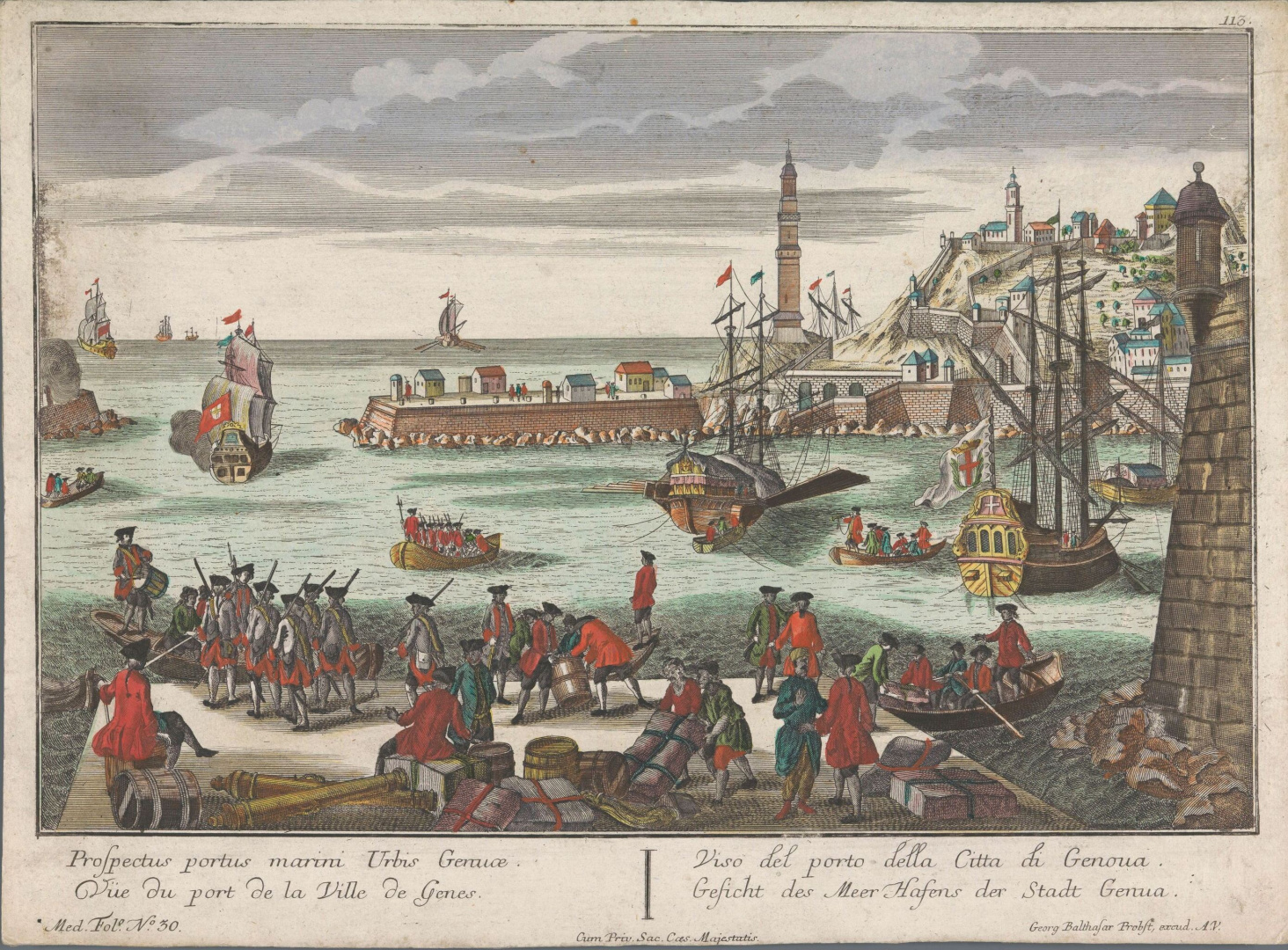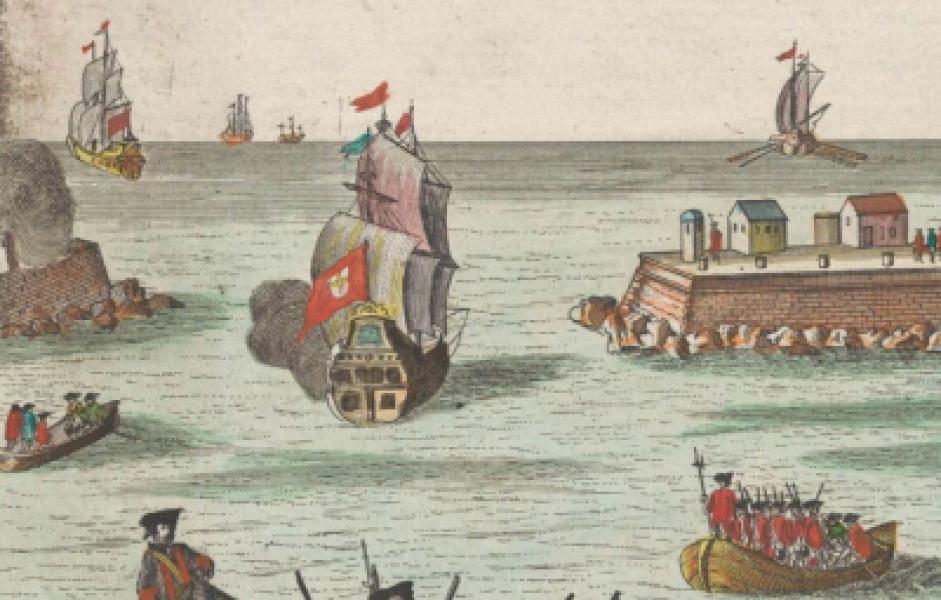The eighteenth-century travel diary of a captain’s son
Between 1783 and 1786, the captain’s son Nicolaas Abraham van Rijneveld (1766-1849) was on board the Noordholland (North Holland), the ship of the line commanded by his father, Captain Daniël Jan van Rijneveld (1742-1795). In the first part of this blog, I introduced Nicolaas’s published travel diary, Reize naar de Middelandsche Zee (Journey to the Mediterranean Sea) (1803), and in the second part I described the route of the Noordholland. Part III focused on Pisa, and central to this part is Nicolaas’s visit to Genoa.
In his diary, Nicolaas describes in detail the geographical location of the coastal city of Genoa. He also pays attention to the fertility of the soil: in the centre of the city, it was quite barren, but at the seaside nature was ‘mild in the production of many and various kinds of Plants, Crops, Herbs, Trees and Flowers, both for livelihood and delight, and also to great profit and advantage of the Genoese, made serviceable by the trade’. Important for the trade were, according to him, the ‘Orange Apples, Lemons and Limes, as well as the Olives’. (Van Rijneveld 1803: 339) Nicolaas was impressed by the beautiful buildings, the fine furniture inside and the clean streets. He also discusses the ‘state of the defence of the city’ – something that was probably of different interest to a contemporary reader than it is now to a modern one. (340) According to Nicolaas, Genoa did justice to its nickname La Superba, the proud or beautiful. That Genoa was a beautiful city could already be seen when you arrive; then the city, with its uneven ground, even looks like an amphitheatre.
In his diary, Nicolaas describes in detail the geographical location of the coastal city of Genoa. He also pays attention to the fertility of the soil: in the centre of the city, it was quite barren, but at the seaside nature was ‘mild in the production of many and various kinds of Plants, Crops, Herbs, Trees and Flowers, both for livelihood and delight, and also to great profit and advantage of the Genoese, made serviceable by the trade’. Important for the trade were, according to him, the ‘Orange Apples, Lemons and Limes, as well as the Olives’. (Van Rijneveld 1803: 339) Nicolaas was impressed by the beautiful buildings, the fine furniture inside and the clean streets. He also discusses the ‘state of the defence of the city’ – something that was probably of different interest to a contemporary reader than it is now to a modern one. (340) According to Nicolaas, Genoa did justice to its nickname La Superba, the proud or beautiful. That Genoa was a beautiful city could already be seen when you arrive; then the city, with its uneven ground, even looks like an amphitheatre.

Nicolaas notes that in the city there was a lot of attention for the poor relief. This was evident, for example, from the many almshouses, charitable institutions, hospitals and hospices there. According to Nicolaas, this suggested that the people (and especially the upper layers of the population) cared about this. Moreover, these poorhouses and hospitals were beautifully decorated, which made them look more like palaces. Tourists should definitely visit ‘The Great Hospital’ and ‘L’Albergo’ according to Nicolaas. (342) These buildings were beautifully enriched with marble and contained beautiful statues. When Nicolaas visited the Great Hospital, there were at least three thousand sick people there, without any shortage of space.
The arrangement in this Hospital was excellent; the sick were all lying in iron cribs with very good and clean bedding; divided into several rooms, according to the nature of their ailments or diseases; also the rooms for men, women or children were all separately built, spacious and airy. All kinds of people, without distinction of nations or sects, are lovingly received, housed and cured in this hospital; near this hospital there is also a church, in which the relics of St. Catherine of Genoa are displayed. (343)
L’Albergo was for poor people. In principle, they were fed and housed here free of charge, but sometimes they paid a little boarding fee. However, this house had an additional function, ‘namely to discipline, and if possible, to improve the shameless women, who have led a bad and exasperating life, and who have been arrested and placed there by the police’. (344)
Nicolaas also visited a number of religious buildings. Genoa had no fewer than 39 churches, monasteries and abbeys during Nicolaas’s visit. According to Nicolaas, these places of worship were even more beautiful than the secular buildings, and they underlined the city’s nickname. In his travel diary, he paid attention to the treasures and rarities, the sculptures and paintings, and the memorials of antiquity. For example, in Sacro Catino, Genoa’s main church, he saw an ancient emerald vase that had been in the possession of the church since 1101. According to a myth, this vase was given to King Solomon by the Queen of Sheba. Others believed that Jesus and his disciples ate the Passover Lamb from this vase. Nicolaas also visits the church of St. Siro. A well was dug near this church in the past,
in which, it is said, there used to be a fearsome Basilisk, or Dragon, whose poisonous breath caused men and beasts to die; but by the incantation of the Holy Bishop Siro, this horrible monster was forced to leave this place and to plunge into the sea, thus getting rid of that terrible plague; so as not to forget this case, it has been preserved for posterity by a painting placed in the Choir of the church. (348)
This macabre story does not have a negative influence on Nicolaas’s final verdict of the city. He wrote about the women in Genoa, for instance, who were ‘not unpleasant objects for the traveller, and help to make the stay in this city not seem sad and boring’. (357) But perhaps he was most impressed by Genoa’s classical heritage. Nicolaas therefore regretted that he did not have more time to discover La Superba further.
With Nicolaas’s travel report from Genoa, this series of blogs is concluded. In four short blog articles I have aimed to take you along with Nicolaas, both at sea and ashore. His travel diary provides a unique insight into eighteenth-century seafaring. Yet, at least two hundred years later, you will undoubtedly be able to draw parallels between your own travel behaviour and that of Nicolaas.
Bibliography
Van Rijneveld, N.A., Reize naar de Middelandsche Zee, Amsterdam 1803.
